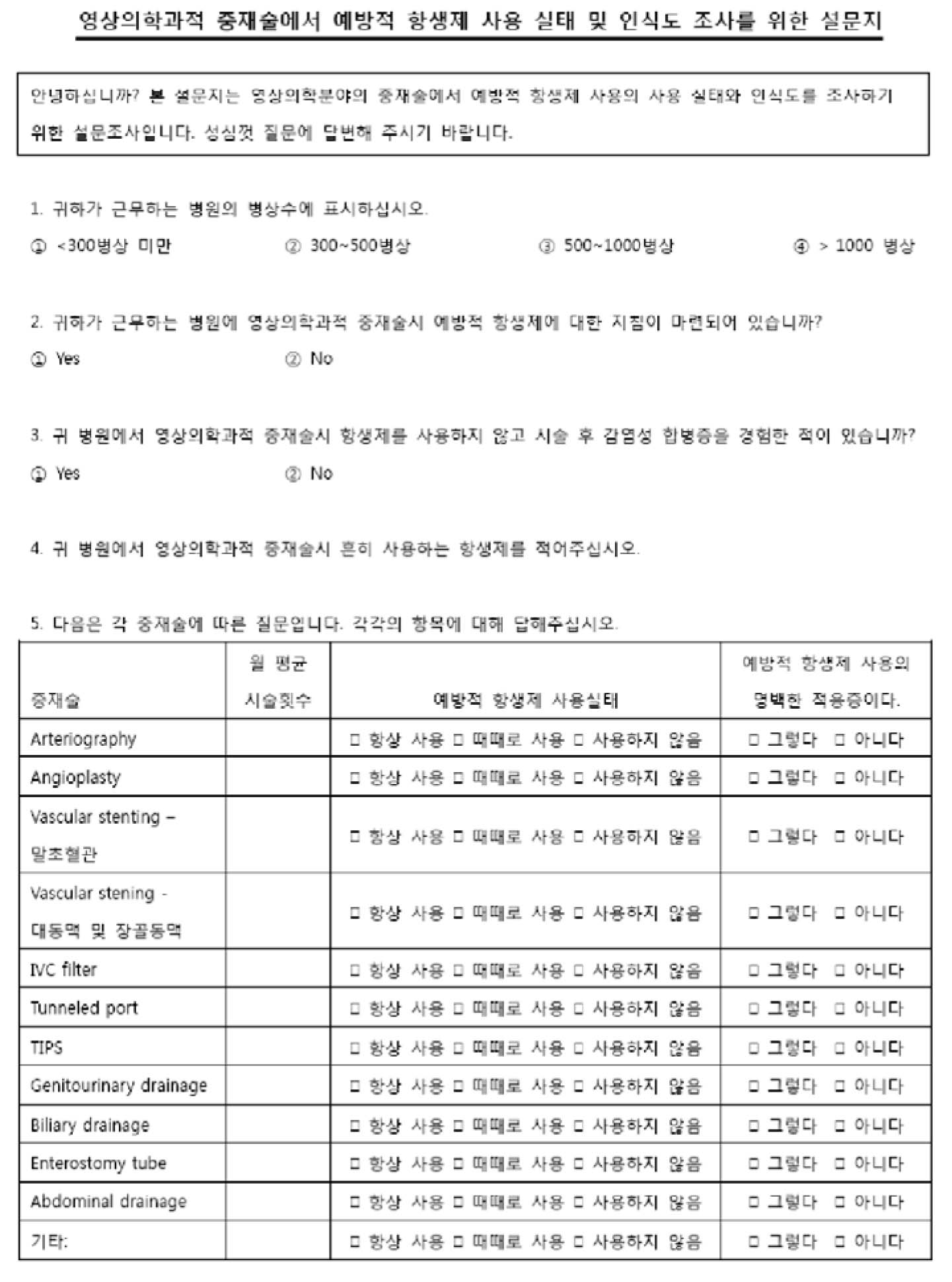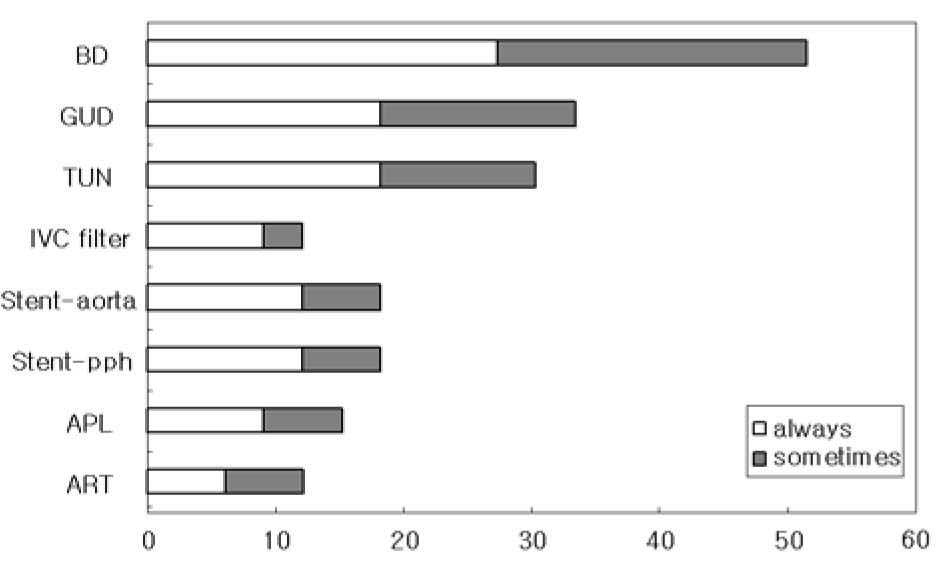Infect Chemother.
2008 Oct;40(5):266-270. 10.3947/ic.2008.40.5.266.
Investigation of Prophylactic Antibiotic Usage for Interventional Radiology in Korea
- Affiliations
-
- 1Department of Internal Medicine, Chonnam National University Medical School, Gwangju, Korea. sijung@chonnam.ac.kr
- 2Department of Diagnostic Radiology, Chonnam National University Medical School, Gwangju, Korea.
- KMID: 2285050
- DOI: http://doi.org/10.3947/ic.2008.40.5.266
Abstract
- Every interventional procedure can result in infectious complication even though its incidence is very low. Increases in both indication of procedures and number of immunocompromised patients are likely to result in increase of infectious complications. However, no randomized controlled trials to evaluate the effectiveness of prophylactic antibiotics in interventional procedures have ever been performed. This study was performed to investigate the actual pattern of practice and awareness of medical providers concerning the antibiotic prophylaxis following vascular and nonvascular interventional procedures. A questionnaire regarding prophylactic antibiotic usage was sent to the interventional radiologists in 40 hospitals. A total of 12.2-30.3% responders used prophylactic antibiotics for vascular procedure. More than 80-90% of responders answered that vascular procedures except catheter insertion, are not clear indications of prophylactic antibiotics. In contrast, 31.3% and 51.5% of responders used prophylactic antibiotics for genitourinary and biliary drainage respectively. About 60-70% of responders considered both genitourinary and biliary drainage as clear indications of antibiotic prophylaxis. Further study assessing the appropriate antibiotic usage in interventional procedures is warranted.
MeSH Terms
Figure
Cited by 1 articles
-
Overview of Antibiotic Use in Korea
Baek-Nam Kim
Infect Chemother. 2012;44(4):250-262. doi: 10.3947/ic.2012.44.4.250.
Reference
-
1. Spies JB, Rosen RJ, Lebowitz AS. Antibiotic prophylaxis in vascular and interventional radiology: a rational approach. Radiology. 1998. 166:381–387.
Article2. McDermott VG, Schuster MG, Smith TP. Antibiotic prophylaxis in vascular and interventional radiology. Am J Roentgenol. 1997. 169:318.
Article3. Ryan JM, Ryan BM, Smith TP. Antibiotic prophylaxis in interventional radiology. J Vasc Interv Radiol. 2004. 15:547–556.
Article4. Beddy P, Ryan JM. Antibiotic prophylaxis in interventional radiology-anything new? Tech Vasc Interv Radiol. 2006. 9:69–76.
Article5. Mangram AJ, Horan TC, Pearson ML, Silver LC, Jarvis WR. Guideline for prevention of surgical site infection, 1999. Centers for Disease Control and Prevention (CDC) Hospital Infection Control Practices Advisory Committee. Am J Infect Control. 1999. 27:97–132.6. Paget DS, Bukhari RH, Zayyat EJ, Lohr JM, Roberts WH, Welling RE. Infectibility of endovascular stents following antibiotic prophylaxis or after arterial wall incorporation. Am J Surg. 1999. 178:219–224.
Article7. Fiorani P, Speziale F, Calisti A, Misuraca M, Zaccagnini D, Rizzo L, Giannoni MF. vascular graft infection: preliminary results of an international enquiry. J Endovasc Ther. 2003. 10:919–927.
Article8. Chambers CE, Eisenhauer MD, McNicol LB, Block PC, Phillips WJ, Dehmer GJ, Heupler FA, Blankenship JC. Members of the Catheterization Lab Performance Standards Committee for the Socitey for Cardiovascular Angiography and Interventions. Infection control guidelines for the cardiac catheterization laboratory: society guidelines revisited. Catheter Cardiovasc Interv. 2006. 67:78–86.
Article9. Malek AM, Higashida RT, Reilly LM, Smith WS, Kang SM, Gress DR, Meyers PM, Phatouros CC, Halbach VV, Dowd CF. Subclavian arteritis and pseudoaneurysm formation secondary to stent infection. Cardiovasc Intervent Radiol. 2000. 23:57–60.
Article10. O'Grady NP, Alexander M, Dellinger EP, Gerberding JL, Heard SO, Maki DG, Masur H, McCormick RD, Mermel LA, Pearson ML, Raad II, Randolph A, Weinstein RA. Guidelines for the prevention of intravascular catheter-related infections. Centers for Disease Control and Prevention. MMWR Recomm Rep. 2002. 51(RR-10):1–29.11. Cochran ST, Barbaric ZL, Lee JJ, Kashfian P. Percutaneous nephrostomy tube placement: an outpatient procedure? Radiology. 1991. 179:843–847.
Article12. Yee AC, Ho CS. Complications of percutaneous biliary drainage: benign vs malignant diseases. Am J Roentgenol. 1987. 148:1207–1209.
Article13. Burke DR, Lewis CA, Cardella JF, Citron SJ, Drooz AT, Haskal ZJ, Husted JW, McCowan TC, Van Moore A, Oglevie SB, Sacks D, Spies JB, Towbin RB, Bakal CW. Society of Interventional Radiology Standards of Practice Committee. Quality improvement guidelines for percutaneous transhepatic cholangiography and biliary drainage. J Vasc Interv Radiol. 2003. 14:S243–S2S6.14. Wayne PH 3rd, Whelan JG Jr. Susceptibility testing of biliary bacteria obtained before bile duct manipulation. Am J Roentgenol. 1983. 140:1185–1188.
Article
- Full Text Links
- Actions
-
Cited
- CITED
-
- Close
- Share
- Similar articles
-
- Usage Analysis of Surgical Prophylaxis of Cephalosporins and Aminoglycosides in a University Hospital
- Myths and Misconceptions around Antibiotic Resistance: Time to Get Rid of Them
- Evaluation of postoperative prophylactic antibiotic medication in third molar surgery
- A Survey on Antimicrobial Prescriptions and Stewardship Programs in Korea
- Antibiotic Use in Pediatric Dentistry




